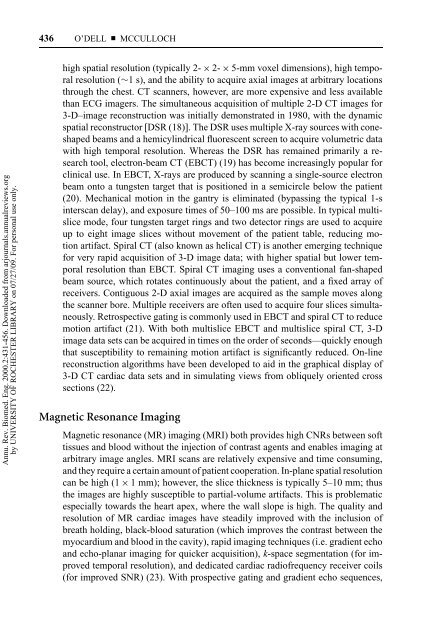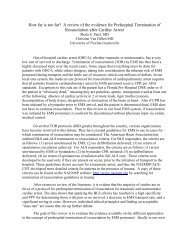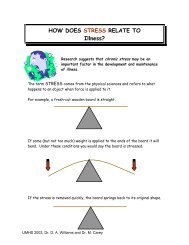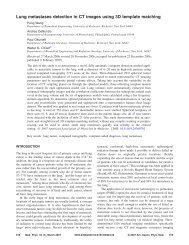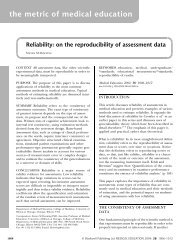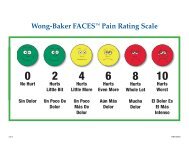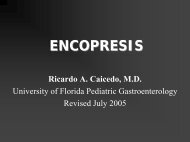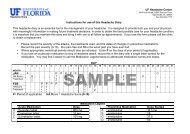imaging three-dimensional cardiac function - Walter G. O'Dell, PhD
imaging three-dimensional cardiac function - Walter G. O'Dell, PhD
imaging three-dimensional cardiac function - Walter G. O'Dell, PhD
You also want an ePaper? Increase the reach of your titles
YUMPU automatically turns print PDFs into web optimized ePapers that Google loves.
436 O’DELL MCCULLOCHAnnu. Rev. Biomed. Eng. 2000.2:431-456. Downloaded from arjournals.annualreviews.orgby UNIVERSITY OF ROCHESTER LIBRARY on 07/27/09. For personal use only.?Magnetic Resonance Imaginghigh spatial resolution (typically 2- × 2- × 5-mm voxel dimensions), high temporalresolution (∼1 s), and the ability to acquire axial images at arbitrary locationsthrough the chest. CT scanners, however, are more expensive and less availablethan ECG imagers. The simultaneous acquisition of multiple 2-D CT images for3-D–image reconstruction was initially demonstrated in 1980, with the dynamicspatial reconstructor [DSR (18)]. The DSR uses multiple X-ray sources with coneshapedbeams and a hemicylindrical fluorescent screen to acquire volumetric datawith high temporal resolution. Whereas the DSR has remained primarily a researchtool, electron-beam CT (EBCT) (19) has become increasingly popular forclinical use. In EBCT, X-rays are produced by scanning a single-source electronbeam onto a tungsten target that is positioned in a semicircle below the patient(20). Mechanical motion in the gantry is eliminated (bypassing the typical 1-sinterscan delay), and exposure times of 50–100 ms are possible. In typical multislicemode, four tungsten target rings and two detector rings are used to acquireup to eight image slices without movement of the patient table, reducing motionartifact. Spiral CT (also known as helical CT) is another emerging techniquefor very rapid acquisition of 3-D image data; with higher spatial but lower temporalresolution than EBCT. Spiral CT <strong>imaging</strong> uses a conventional fan-shapedbeam source, which rotates continuously about the patient, and a fixed array ofreceivers. Contiguous 2-D axial images are acquired as the sample moves alongthe scanner bore. Multiple receivers are often used to acquire four slices simultaneously.Retrospective gating is commonly used in EBCT and spiral CT to reducemotion artifact (21). With both multislice EBCT and multislice spiral CT, 3-Dimage data sets can be acquired in times on the order of seconds—quickly enoughthat susceptibility to remaining motion artifact is significantly reduced. On-linereconstruction algorithms have been developed to aid in the graphical display of3-D CT <strong>cardiac</strong> data sets and in simulating views from obliquely oriented crosssections (22).Magnetic resonance (MR) <strong>imaging</strong> (MRI) both provides high CNRs between softtissues and blood without the injection of contrast agents and enables <strong>imaging</strong> atarbitrary image angles. MRI scans are relatively expensive and time consuming,and they require a certain amount of patient cooperation. In-plane spatial resolutioncan be high (1 × 1 mm); however, the slice thickness is typically 5–10 mm; thusthe images are highly susceptible to partial-volume artifacts. This is problematicespecially towards the heart apex, where the wall slope is high. The quality andresolution of MR <strong>cardiac</strong> images have steadily improved with the inclusion ofbreath holding, black-blood saturation (which improves the contrast between themyocardium and blood in the cavity), rapid <strong>imaging</strong> techniques (i.e. gradient echoand echo-planar <strong>imaging</strong> for quicker acquisition), k-space segmentation (for improvedtemporal resolution), and dedicated <strong>cardiac</strong> radiofrequency receiver coils(for improved SNR) (23). With prospective gating and gradient echo sequences,


